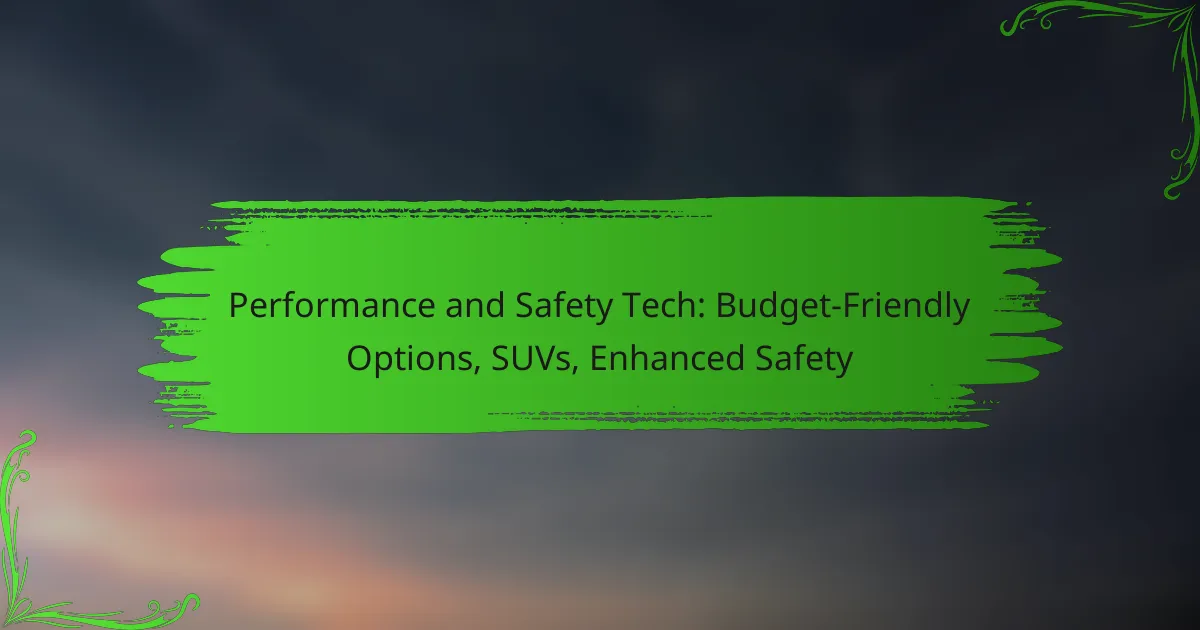For those seeking budget-friendly SUVs, there are numerous options that prioritize enhanced safety features, making them perfect for families and safety-conscious drivers. Models such as the Honda CR-V, Subaru Forester, and Toyota RAV4 combine affordability with advanced safety technologies, ensuring a secure driving experience. With performance and safety technologies like adaptive cruise control and automatic emergency braking, these vehicles not only enhance convenience but also significantly improve safety ratings, guiding consumers in their purchasing decisions.

What Are the Best Budget-Friendly SUVs with Enhanced Safety Features?
Several budget-friendly SUVs offer enhanced safety features, making them ideal choices for families and individuals prioritizing protection on the road. Models like the Honda CR-V, Subaru Forester, and Toyota RAV4 stand out for their combination of affordability, reliability, and advanced safety technologies.
2023 Honda CR-V
The 2023 Honda CR-V is known for its spacious interior and impressive safety ratings. It comes equipped with Honda Sensing, a suite of safety features that includes collision mitigation braking, lane keeping assist, and adaptive cruise control.
This SUV also boasts a five-star overall safety rating from the National Highway Traffic Safety Administration (NHTSA), making it a reliable choice for budget-conscious buyers. Its fuel efficiency further enhances its appeal, averaging around 28-30 miles per gallon.
2023 Subaru Forester
The 2023 Subaru Forester is a standout in the compact SUV segment, offering standard all-wheel drive and a robust set of safety features. Subaru’s EyeSight Driver Assist Technology includes features like pre-collision braking and lane departure warning.
With a strong reputation for safety, the Forester consistently earns high marks from safety organizations, making it a practical choice for families. Its spacious cargo area and excellent visibility add to its overall functionality.
2023 Toyota RAV4
The 2023 Toyota RAV4 combines affordability with a comprehensive safety package, including Toyota Safety Sense, which features adaptive cruise control, lane departure alert, and automatic high beams. This model is designed to keep drivers and passengers safe in various driving conditions.
Additionally, the RAV4 offers a comfortable ride and good fuel economy, averaging around 27-30 miles per gallon. Its reliability and resale value make it a smart investment for budget-minded consumers.
2023 Mazda CX-5
The 2023 Mazda CX-5 is praised for its stylish design and engaging driving experience, along with a suite of safety features. It includes advanced technologies such as blind-spot monitoring and rear cross-traffic alert, enhancing overall safety for drivers.
This SUV also scores well in crash tests, providing peace of mind for buyers. With a fuel economy of approximately 24-28 miles per gallon, it balances performance with efficiency, making it a great option for those on a budget.
2023 Hyundai Tucson
The 2023 Hyundai Tucson offers a strong value proposition with its extensive list of standard safety features, including forward collision-avoidance assist and lane keeping assist. Its modern design and spacious interior make it appealing for families.
With a solid safety rating and an average fuel economy of around 26-29 miles per gallon, the Tucson is both practical and economical. Its warranty coverage is among the best in the industry, providing additional reassurance for budget-conscious buyers.

How Do Performance and Safety Technologies Impact SUV Choices?
Performance and safety technologies significantly influence SUV selections by enhancing driving experience and ensuring passenger protection. Features like adaptive cruise control, lane keeping assist, and automatic emergency braking not only improve convenience but also contribute to overall safety ratings, making them essential considerations for buyers.
Adaptive Cruise Control Benefits
Adaptive cruise control (ACC) automatically adjusts a vehicle’s speed to maintain a safe distance from the car ahead. This technology is particularly beneficial in highway driving, where it can reduce fatigue by managing speed and braking without constant driver input.
When choosing an SUV with ACC, consider how well it responds to varying traffic conditions. Some systems may struggle in heavy stop-and-go traffic, while others excel. Look for models that offer smooth acceleration and braking for a more comfortable ride.
Lane Keeping Assist Features
Lane keeping assist (LKA) helps drivers stay within their lane by providing steering assistance when it detects unintentional lane departures. This feature can be particularly useful on long trips, reducing the risk of drifting and enhancing overall safety.
When evaluating SUVs for LKA, check how effectively the system detects lane markings and whether it can handle curves. Some systems may require more frequent driver intervention, while advanced options can provide a more hands-free experience.
Automatic Emergency Braking Systems
Automatic emergency braking (AEB) systems detect potential collisions and apply the brakes if the driver does not respond in time. This technology can significantly reduce the severity of accidents or even prevent them altogether, making it a critical safety feature in modern SUVs.
Look for SUVs that meet or exceed the latest safety ratings for AEB, as performance can vary widely. Systems that function well in both day and night conditions, as well as in adverse weather, are particularly valuable. Ensure the vehicle’s AEB system is tested under real-world scenarios for maximum effectiveness.

What Are the Key Safety Ratings for SUVs?
The key safety ratings for SUVs are determined by organizations that evaluate vehicle performance in crash tests and safety features. These ratings help consumers make informed decisions about the safety of their vehicles, focusing on crashworthiness, crash avoidance, and overall safety technology.
National Highway Traffic Safety Administration Ratings
The National Highway Traffic Safety Administration (NHTSA) provides a star rating system that evaluates vehicles based on their performance in various crash tests. Ratings range from one to five stars, with five stars indicating the highest level of safety. Factors considered include frontal crash, side crash, and rollover tests.
When assessing NHTSA ratings, look for vehicles with at least four stars, as this suggests a solid level of safety. Additionally, consider the presence of advanced safety features such as automatic emergency braking and lane-keeping assist, which can enhance overall safety ratings.
Insurance Institute for Highway Safety Ratings
The Insurance Institute for Highway Safety (IIHS) conducts rigorous testing and provides ratings based on crashworthiness and crash avoidance technology. Their ratings include categories like “Good,” “Acceptable,” “Marginal,” and “Poor,” with “Good” being the highest rating. IIHS tests include front moderate overlap, side impact, and roof strength.
For a vehicle to be recognized as a Top Safety Pick, it must earn “Good” ratings in key areas and meet specific criteria for front crash prevention. When shopping for an SUV, prioritize those with IIHS Top Safety Pick awards, as they indicate superior safety performance in real-world scenarios.

How to Choose a Budget SUV with Advanced Safety Tech?
Choosing a budget SUV with advanced safety technology involves balancing cost with essential safety features. Focus on models that offer high safety ratings, reliable performance, and overall value to ensure you make a sound investment.
Evaluate Safety Ratings
Start by checking safety ratings from reputable organizations like the National Highway Traffic Safety Administration (NHTSA) and the Insurance Institute for Highway Safety (IIHS). Look for SUVs that have received top marks in crash tests and have advanced safety features such as automatic emergency braking and lane-keeping assist.
Consider vehicles that come equipped with driver assistance technologies, as these can significantly enhance safety. Models with a five-star overall rating are generally a good choice, indicating a strong performance in various safety assessments.
Compare Performance Features
When comparing performance features, assess the engine options, handling, and fuel efficiency of each SUV. Look for models that offer a balance of power and efficiency, ideally achieving at least 25 miles per gallon in combined city and highway driving.
Additionally, consider the driving experience, including features like all-wheel drive for better traction in adverse weather. Test-driving different models can help you gauge how they handle on the road and whether they meet your performance expectations.
Assess Cost vs. Value
Evaluate the total cost of ownership, including purchase price, insurance, maintenance, and fuel costs. Aim for SUVs that provide a good mix of features for the price, ideally in the range of $25,000 to $35,000 for a new model with advanced safety tech.
Be cautious of models that appear inexpensive but may lack essential safety features or have lower reliability ratings. Research ownership reviews and long-term reliability scores to ensure you are getting a vehicle that offers real value for your investment.

What Are the Emerging Trends in SUV Safety Technology?
Emerging trends in SUV safety technology focus on integrating advanced systems that enhance vehicle safety and driver awareness. Key developments include the use of artificial intelligence, advanced driver assistance systems, and features aimed at autonomous driving, all contributing to safer driving experiences.
Integration of AI in Safety Systems
Artificial intelligence is increasingly being integrated into SUV safety systems to improve real-time decision-making. AI can analyze data from various sensors, allowing vehicles to detect potential hazards and respond accordingly. For example, AI can help identify pedestrians or cyclists in the vehicle’s path, triggering alerts or automatic braking.
When considering AI safety features, look for systems that continuously learn and adapt to driving conditions. This adaptability can enhance the effectiveness of safety measures, making them more responsive to unique situations encountered on the road.
Increased Use of Advanced Driver Assistance Systems
Advanced driver assistance systems (ADAS) are becoming standard in many new SUVs, providing features such as lane-keeping assist, adaptive cruise control, and automatic emergency braking. These technologies help reduce the likelihood of accidents by assisting drivers in maintaining control and awareness.
When evaluating SUVs, consider models equipped with comprehensive ADAS packages. Look for features that not only enhance safety but also improve overall driving comfort, such as traffic jam assist, which can ease the strain of stop-and-go traffic.
Development of Autonomous Driving Features
Many manufacturers are investing in the development of autonomous driving features, which aim to reduce human error in driving. These features range from partial automation, where the vehicle can control steering and speed, to full autonomy, where no driver input is required. However, full autonomy is still in the testing phase and may not be widely available for several years.
As you explore SUVs with autonomous capabilities, be aware of the current limitations and regulatory requirements. Ensure that you understand the level of automation offered and the conditions under which these features can be safely used, as regulations may vary by region.

How Will Future Regulations Affect SUV Safety Standards?
Future regulations are expected to significantly enhance SUV safety standards by mandating stricter crash test requirements and advanced safety technologies. These changes will likely lead to improved vehicle designs that prioritize passenger protection and overall road safety.
Impact of Government Regulations
Government regulations play a crucial role in shaping safety standards for SUVs. As authorities implement stricter guidelines, manufacturers must adapt their designs to meet these new requirements, which may include enhanced crashworthiness and the integration of advanced driver-assistance systems (ADAS).
For instance, regulations may require SUVs to undergo more rigorous testing for side-impact collisions and rollover resistance. This can lead to the adoption of stronger materials and innovative engineering solutions that improve vehicle stability and occupant protection.
Consumer Demand for Safer Vehicles
Consumer demand for safer vehicles is driving manufacturers to prioritize safety features in their SUV offerings. Buyers increasingly seek models equipped with the latest safety technologies, such as automatic emergency braking, lane-keeping assist, and adaptive cruise control.
This shift in consumer preferences encourages automakers to invest in research and development, ensuring that their SUVs not only comply with regulations but also exceed customer expectations. As a result, many new models are being designed with a focus on both safety and performance, appealing to a broader market segment.
